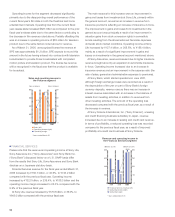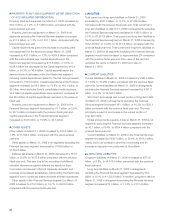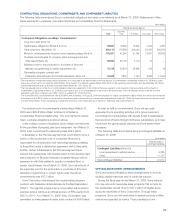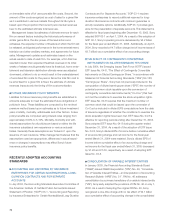Sony 2006 Annual Report Download - page 68
Download and view the complete annual report
Please find page 68 of the 2006 Sony annual report below. You can navigate through the pages in the report by either clicking on the pages listed below, or by using the keyword search tool below to find specific information within the annual report.66
accounted for as a sale in accordance with FAS No. 140,
“Accounting for Transfers and Servicing of Financial Assets and
Extinguishments of Liabilities”, because Sony has relinquished
control of the receivables. Accordingly, accounts receivable sold
under these transactions are excluded from receivables in the
accompanying consolidated balance sheet. The initial sale of
these receivables was in March 2005, and Sony sold a total of
¥10.0 billion for the fiscal year ended March 31, 2005. Sony
sold a total of ¥146.2 billion of receivables during the fiscal year
ended March 31, 2006. Losses from these transactions were
insignificant. Although Sony continues servicing the sold
receivables, no servicing liabilities are recorded because costs
regarding collection of the sold receivables are insignificant.
Through May 2005, Sony had set up an accounts receivable
securitization program in the United States that provided for the
accelerated receipt of up to $500 million of cash on eligible
trade accounts receivable of Sony’s U.S. electronics subsidiary.
Through this program, Sony could securitize and sell a
percentage of an undivided interest in that pool of receivables
to several multi-seller commercial paper conduits owned and
operated by a bank. These securitization transactions were
accounted for as a sale in accordance with FAS No. 140,
because Sony had relinquished control of the receivables.
Accordingly, accounts receivable sold under these transactions
were excluded from receivables in the accompanying
consolidated balance sheet. During the period from April 2004
to January 2005, Sony sold a total of ¥80.3 billion of accounts
receivable under this program. There were no outstanding
amounts due at March 31, 2005 relating to the existing
undivided interests in the pool of receivables that had been sold.
Losses from these transactions were insignificant. This program
was terminated in May 2005.
Refer to Note 7 of Notes to Consolidated Financial Statements
for more information on the accounts receivable securitization.
In addition, a subsidiary in the Picture segment entered into a
production/co-financing agreement with a Variable Interest Entity
(“VIE”) on December 30, 2005, to co-finance 11 films scheduled
to be released over the following 15 months. The subsidiary is
not the primary beneficiary of the VIE and therefore does not
consolidate the results of VIE. Under the production/co-financing
agreement, the subsidiary will receive approximately $400 million
over the term of the agreement. The subsidiary is responsible for
the marketing and distribution of the product through its global
distribution channels. The VIE shares in the net profits of the
films after the subsidiary recoups a distribution fee, its marketing
and distribution expenses, and third party participation and
residual costs. As of March 31, 2006, only one co-financed film
has been released by the subsidiary. The subsidiary did not
make any equity investment in the VIE nor does it issue any
guarantees with respect to the VIE. In April 2006, the subsidiary
entered into a second production/co-financing agreement with
a VIE to co-finance an additional 11 films scheduled to be
released over the following 24 months. The subsidiary will
receive approximately $330 million over the term of the
agreement. Similar to the first agreement, the subsidiary is
responsible for the marketing and distribution of the product
through its global distribution channels. The VIE shares in the net
profits of the films after the subsidiary recoups a distribution fee,
its marketing and distribution expenses, and third party
participation and residual costs.
Sony has, from time to time, entered into various arrangements
with VIEs. In several of the arrangements in which Sony holds a
significant variable interest, Sony is the primary beneficiary and
therefore consolidates these VIEs. These arrangements include
facilities which provide for the leasing of certain property, the
financing of film production, the implementation of a stock
option plan for Japanese employees and the U.S.-based music
publishing business. The assets and liabilities associated with
certain of these arrangements previously qualified for off-balance
sheet treatment. In addition, Sony holds a significant variable
interest in VIEs in which Sony is not the primary beneficiary and
therefore does not consolidate. These VIEs include the film
production/co-financing arrangements noted above.
CASH FLOWS
(The fiscal year ended March 31, 2006 compared with the fiscal
year ended March 31, 2005)
Operating Activities: During the fiscal year ended March 31,
2006, Sony generated ¥399.9 billion of net cash from operating
activities, a decrease of ¥247.1 billion, or 38.2% compared with
the previous fiscal year. Of this total, all segments excluding the
Financial Services segment generated ¥252.0 billion of net cash
from operating activities, a decrease of ¥233.5 billion, or 48.1%,
compared with the previous fiscal year, and the Financial
Services segment generated ¥147.1 billion of net cash from
operating activities, a decrease of ¥20.9 billion, or 12.5%,
compared with the previous fiscal year.
During the fiscal year, there was a positive impact on
operating cash flow mainly from the effect of the profit
contribution from the Financial Services segment, and after
taking account of depreciation and amortization, as well as the
effect of the loss on sale, disposal or impairment of assets, net.
However, primarily offsetting these contributions was an
increase in inventory, particularly within the Electronics and
Game segments, the effect of the non-cash net gain on the
transfer to the Japanese Government of the substitutional
























